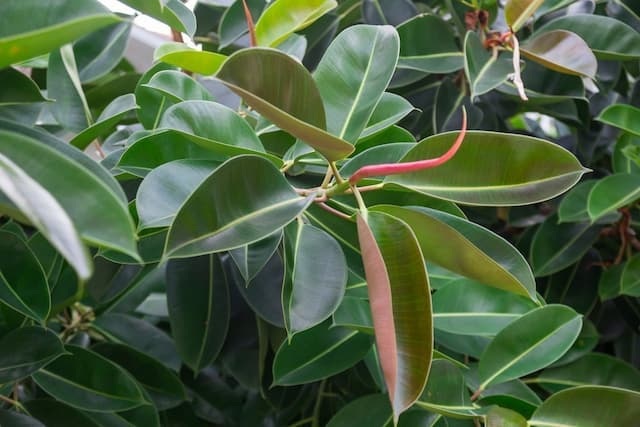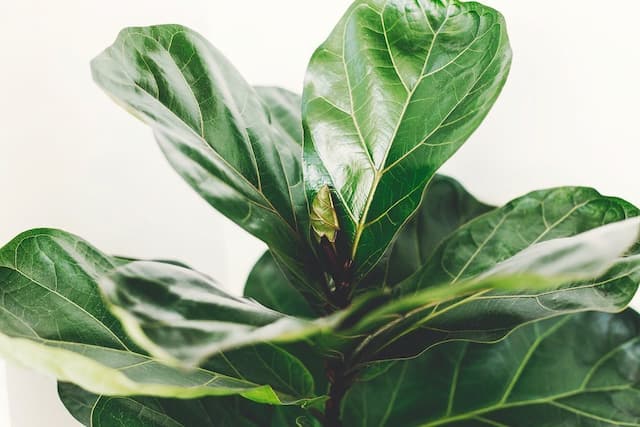Variegated Rubber Plant Ficus elastica 'Doescheri' (v)

ABOUT
Ficus elastica 'Doescheri,' more commonly known as the variegated rubber plant, is an attractive variety of the classic rubber plant. Its leaves are what primarily distinguish it from the standard variety. Each leaf is broad, glossy and leathery in texture, displaying a striking array of green, cream, and pink hues. The variegation pattern includes irregular patches and blended streaks that give each leaf a unique appearance. The contrasting colors can range from deep green to light cream, and the pink hues often accentuate the edges or midrib of the leaves, adding a touch of warmth to the overall color palette. The variegated rubber plant has a robust and upright growth habit, and its leaves grow on thick, sturdy stems that may also show a hint of the variegation seen in the leaves. New leaves typically emerge with a sheath that eventually dries and falls away as the leaf matures and unfurls. This revealing process adds to the aesthetic appeal of the plant, showcasing the new variegated patterns with each growth cycle. The overall impression of the variegated rubber plant is one of a lush and vibrant houseplant, with its unique blend of colors providing a visual interest that complements a wide range of interior decorating styles. It's an ideal choice for those looking to add a touch of natural beauty and color variance to their indoor spaces without the plant becoming too large or unmanageable.
About this plant
 Names
NamesFamily
Moraceae
Synonyms
Variegated Rubber Plant, Doescher's Rubber Plant, Variegated Rubber Tree, Doescher's Rubber Tree
Common names
Ficus elastica 'Doescheri'.
 Toxicity
ToxicityTo humans
The plant commonly known as Rubber Plant may be considered mildly toxic if ingested by humans. The primary irritant in the plant is a milky sap, or latex, which it exudes when the plant is damaged or broken. This sap contains compounds that can cause irritation or an allergic reaction in some people. If ingested, the sap can cause symptoms such as mouth irritation, salivation, vomiting, and difficulty swallowing. Direct contact with the skin can sometimes result in dermatitis or blisters. While typically not life-threatening, it is advisable to keep this plant out of reach of children who might be tempted to chew on its leaves or stem.
To pets
The Rubber Plant is also toxic to pets if ingested. The plant's sap contains irritating compounds that can be harmful to dogs and cats. Symptoms of poisoning in pets can include oral irritation, pawing at the mouth, drooling, vomiting, and difficulty swallowing if they chew on or ingest the plant. The sap can also be irritating to the skin and mucous membranes. Consumption of large amounts of the plant's material could lead to more severe gastrointestinal upset. In the interest of pet safety, it is recommended to place Rubber Plants out of reach of curious animals to prevent accidental ingestion.
 Characteristics
CharacteristicsLife cycle
Perennials
Foliage type
Evergreen
Color of leaves
Variegated
Height
6-10 feet (1.8-3 meters)
Spread
2-3 feet (0.6-0.9 meters)
Plant type
Tree
Hardiness zones
10
Native area
Southeast Asia
Benefits
 General Benefits
General Benefits- Decorative Appeal: The Ficus elastica 'Doescheri', commonly known as the Variegated Rubber Plant, has striking variegated leaves that add aesthetic beauty to any indoor space.
- Low Maintenance: It is a hardy plant that requires minimal care, making it suitable for busy individuals or those with less experience in gardening.
- Adaptability: This plant is adaptable to a range of indoor conditions, from low light to bright, indirect sunlight.
- Humidity Tolerance: The Variegated Rubber Plant can tolerate varying levels of humidity, making it a good choice for different indoor environments.
- Longevity: With proper care, this plant can live for many years, providing a long-term decorative feature for homes or offices.
- Growth Habit: It can be pruned to maintain a desired size and shape, fitting well in various spaces within homes and offices.
- Stress Reduction: Like many houseplants, it can contribute to a calming atmosphere and lessen stress in living or working areas.
 Medical Properties
Medical PropertiesThis plant is not used for medical purposes.
 Air-purifying Qualities
Air-purifying QualitiesThis plant is not specifically known for air purifying qualities.
 Other Uses
Other Uses- Ficus elastica 'Doescheri', also known as variegated rubber plant, can be used as a natural rubber substitute for small-scale DIY projects, such as making handmade stamps or grips for tools.
- The sap of the variegated rubber plant could potentially be used in traditional crafts, like creating natural adhesives for papercraft or as a thickening agent in some art paint applications.
- Adding texture to craft projects, the broad, patterned leaves of the variegated rubber plant can be used as templates or molds for creating designs in clay or plaster projects.
- In the fashion industry, the leaves' texture and pattern might inspire designs for fabrics, accessories, or even in developing environmentally-themed prints and motifs.
- Botanical art can employ the leaves of variegated rubber plants as subjects for photography or illustration, capturing their unique patterns and contributing to nature-inspired artwork.
- The plant’s aesthetically appealing variegation can be used in color psychology studies to understand the impact of green spaces and plant heterogeneity on human well-being.
- When dried and preserved correctly, the leaves of the variegated rubber plant could be utilized in scrapbooking or as a natural alternative to conventional bookmarks.
- In educational settings, the variegated rubber plant may serve as a model organism to teach about variegation, plant genetics, and the care of houseplants in biology classes.
- The wood of older, larger variegated rubber plants might be repurposed for creating lightweight objects, like small carvings or frames for photos or mirrors once the plant has reached the end of its lifespan.
- As a living sculpture, the variegated rubber plant can be used in artistic installations or interior design projects to add a dynamic visual element that combines art and nature.
Interesting Facts
 Feng Shui
Feng ShuiThe Rubber Plant is used in Feng Shui to bring in wealth, abundance, and good luck. It is recommended to place it in the wealth corner of your home or office, which is the southeast sector, to activate these positive energies.
 Zodiac Sign Compitability
Zodiac Sign CompitabilityThe Rubber Plant is not used in astrology practice.
 Plant Symbolism
Plant Symbolism- Resilience: The rubber plant (Ficus elastica) is known for its robustness and ability to bounce back, symbolizing the strength to recover from challenges.
- Growth: As a fast-growing plant, the rubber plant represents personal or professional growth, as well as the potential for expansion in one's life.
- Adaptability: Given its versatility in growing in different environments, the rubber plant can symbolize adaptability and the ability to thrive in various conditions.
- Prosperity: In the context of Feng Shui, rubber plants are said to attract wealth and prosperity, making them a symbol of financial success.
- Air Purification: With its air-purifying qualities, the rubber plant is often associated with health, renewal, and the cleansing of one's environment.
 Water
WaterThe Rubber Plant requires watering when the top inch of soil feels dry to the touch, typically every week to 10 days during the growing season and less often during winter. Use room-temperature water and thoroughly soak the soil until water runs through the drainage holes. It's essential not to let the plant sit in water, as this can lead to root rot. Depending on the size of the pot, you might use 16 to 32 ounces of water in a session. Always check the soil before watering to ensure it is necessary, as overwatering can be detrimental.
 Light
LightThe Rubber Plant thrives in bright, indirect light and can tolerate some direct morning sunlight. However, too much direct sunlight can scorch its leaves. A spot near a window with a sheer curtain to diffuse light is ideal. Rotating the plant occasionally will ensure all sides receive equal light and maintain even growth.
 Temperature
TemperatureThe Rubber Plant prefers a comfortable room temperature between 60 and 75 degrees Fahrenheit. It can survive temporarily in temperatures as low as 50 degrees Fahrenheit, but growth may slow. Avoid placing the plant in areas with cold drafts or sudden temperature changes for optimal health.
 Pruning
PruningPruning the Rubber Plant is necessary to maintain its shape and promote bushier growth. Prune in the spring or early summer when the plant is actively growing, cutting back any leggy or overgrowth. Use sharp, clean shears to remove unwanted leaves and branches, and always prune just above the leaf nodes to encourage new shoots.
 Cleaning
CleaningAs needed
 Soil
SoilThe best soil mix for Variegated Rubber Plant is well-draining and rich in organic matter. A mixture of one part potting soil, one part perlite or coarse sand, and one part peat or coir would be ideal. The soil pH should be slightly acidic to neutral, ranging from 5.5 to 7.5 for optimal growth.
 Repotting
RepottingVariegated Rubber Plants should be repotted every 2-3 years to encourage growth and prevent soil nutrient depletion. Younger plants may need repotting more frequently, typically every 1-2 years, as they can outgrow their pots faster than mature plants.
 Humidity & Misting
Humidity & MistingThe Variegated Rubber Plant thrives in moderate to high humidity levels, ideally between 40-60%. If the air is too dry, the plant's leaves may start to brown at the edges. Using a humidifier or placing a pebble tray with water beneath the plant can help maintain adequate humidity levels.
 Suitable locations
Suitable locationsIndoor
Provide bright, indirect light and water when topsoil is dry.
Outdoor
Sheltered spot, indirect light, protect below 50°F, well-draining soil.
Hardiness zone
10-12 USDA
 Life cycle
Life cycleThe Ficus elastica 'Doescheri', commonly known as the Variegated Rubber Plant, begins its life as a seed, which, upon finding the right conditions of warmth and moisture, will germinate. The seedling stage follows, characterized by the emergence of roots and the first few leaves, with variegation patterns starting to appear. As the plant enters the juvenile stage, it experiences rapid growth and an increase in leaf size; during this time, regular watering and bright, indirect light are crucial for development. Transitioning to maturity, the rubber plant develops a thicker, woody trunk, robust branches, and more pronounced variegated foliage that can be enhanced with proper pruning. In its adult stage, given optimal conditions, it might produce flowers and subsequently seeds, although flowering is rare in indoor conditions. The mature plant requires periodic repotting to accommodate growth and may live for many years with appropriate care, completing its life cycle if it manages to reproduce through pollination and seed development.
 Propogation
PropogationPropogation time
Spring-Early Summer
Propogation: The most popular method of propagating the Rubber Plant, particularly Ficus elastica 'Doescheri', is through stem cuttings. The ideal time for taking cuttings is during the warmer months of spring or early summer, when the plant is actively growing. To propagate, a healthy stem cutting about 6 to 8 inches long should be sliced at an angle just below a leaf node. The cut end can then be dipped in rooting hormone to encourage root development, though this is optional. The cutting is then placed in a pot filled with well-draining potting mix, ensuring that at least one leaf node is buried beneath the soil surface. The soil should be kept moist but not soaking wet, and the pot should be placed in bright, indirect light. It typically takes a few weeks for roots to establish, after which you can continue to care for the new Rubber Plant as you would a mature one.




